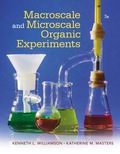
EBK MACROSCALE AND MICROSCALE ORGANIC E
7th Edition
ISBN: 8220101437488
Author: Williamson
Publisher: YUZU
expand_more
expand_more
format_list_bulleted
Textbook Question
Chapter 6, Problem 7Q
Did sublimation aid in the purification of the unknown in Part 3? Justify your answer.
Expert Solution & Answer
Want to see the full answer?
Check out a sample textbook solution
Students have asked these similar questions
Don't used Ai solution
Draw resonance structures for the following compounds.
Please provide a thorough explanation that allows for undertanding of topic.
BF3 has a no dipole moment. a) Draw the Lewis structure for BF3, showing all nonbonding electrons. b) Indicate the polarity of every atom in the structure using δ+ and δ– notation, and explain why the molecule has no net dipole.
Please provide a thorough explanation that allows for undertanding of topic.
Chapter 6 Solutions
EBK MACROSCALE AND MICROSCALE ORGANIC E
Ch. 6 - Assign the peaks in the 1H NMR spectrum of eugenol...Ch. 6 - A mixture of ethyl iodide (C2H5I,bp72.3C) and...Ch. 6 - Prob. 3QCh. 6 - Prob. 4QCh. 6 - Prob. 5QCh. 6 - A mixture of toluene (bp110.8C) and water is steam...Ch. 6 - Did sublimation aid in the purification of the...Ch. 6 - Prob. 8QCh. 6 - Prob. 9QCh. 6 - Prob. 10Q
Knowledge Booster
Learn more about
Need a deep-dive on the concept behind this application? Look no further. Learn more about this topic, chemistry and related others by exploring similar questions and additional content below.Similar questions
- For each reaction shown below follow the curved arrows to complete each equation by showing the structure of the products. Identify the acid, the base, the conjugated acid and conjugated base. Consutl a pKa table and choose the direciton the equilibrium goes. Please provide a thorough explanation that allows for undertanding of topic.arrow_forwardNeed help understanding please help Let’s assume the initial volume of the gas is 4.80 LL , the initial temperature of the gas is 29.0 °C°C , and the system is in equilibrium with an external pressure of 1.2 bar (given by the sum of a 1 bar atmospheric pressure and a 0.2 bar pressure due to a brick that rests on top of the piston). What is the final pressure of the gas? What is the final volume of the gas? What happens with the piston after you finish heating the gas? Assume you do not need to worry about the gas cooling down again because the outside of the container is at a lower temperature. That is, you manage to keep the gas at a constant temperature that equals 54.2 °C°C What is the sign of w? What is the value of w? Be careful with units. How do you convert bar*L to J?arrow_forwardFor a neutral hydrogen atom with an electron in the n = 4 state, how many different energies are possible when a photon is emitted?arrow_forward
- For the following compound identify the lone pairs and indicate if each lone pair is localized or delocalized. Please provide a thorough explanation that allows for undertanding of topic.arrow_forwardWhat is the relationship between the following compounds? Choose between: (a)constitutional isomers, (b)resonance structures, (c)identical, (d) conformers Please provide a thorough explanation that allows for undertanding of topic.arrow_forwardCaffeine has the following structure. What is the hybridization state and molecular geometry at each nitrogen atom in Caffeine? Please provide a thorough explanation that allows for undertanding of topic.arrow_forward
- What are the major products of the following reaction? Draw all the major products. If there are no major products, then there is no reaction that will take place. Use wedge and dash bonds when necessary.arrow_forwardTryptophan is an essential amino acid important in the synthesis of neurotransmitter serotonin in the body. What are the hybridization states, molecular geometry and approximate bond angle at the indicated carbon and nitrogen atoms? Please provide a thorough explanation that allows for undertanding of topic.arrow_forwardCan the target compound be efficiently synthesized in good yield from the substituted benzene of the starting material? If yes, draw the synthesis. Include all steps and all reactants.arrow_forward
arrow_back_ios
SEE MORE QUESTIONS
arrow_forward_ios
Recommended textbooks for you
 Macroscale and Microscale Organic ExperimentsChemistryISBN:9781305577190Author:Kenneth L. Williamson, Katherine M. MastersPublisher:Brooks Cole
Macroscale and Microscale Organic ExperimentsChemistryISBN:9781305577190Author:Kenneth L. Williamson, Katherine M. MastersPublisher:Brooks Cole Chemical Principles in the LaboratoryChemistryISBN:9781305264434Author:Emil Slowinski, Wayne C. Wolsey, Robert RossiPublisher:Brooks Cole
Chemical Principles in the LaboratoryChemistryISBN:9781305264434Author:Emil Slowinski, Wayne C. Wolsey, Robert RossiPublisher:Brooks Cole

Macroscale and Microscale Organic Experiments
Chemistry
ISBN:9781305577190
Author:Kenneth L. Williamson, Katherine M. Masters
Publisher:Brooks Cole

Chemical Principles in the Laboratory
Chemistry
ISBN:9781305264434
Author:Emil Slowinski, Wayne C. Wolsey, Robert Rossi
Publisher:Brooks Cole

Thermogravimetric Analysis [ TGA ] # Thermal Analysis # Analytical Chemistry Part-11# CSIR NET/GATE; Author: Priyanka Jain;https://www.youtube.com/watch?v=p1K-Jpzylso;License: Standard YouTube License, CC-BY